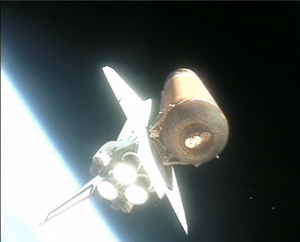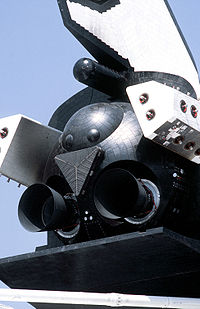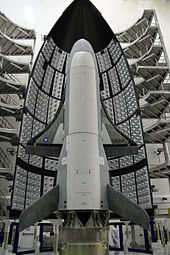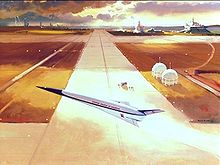- Spaceplane
-
A spaceplane is a vehicle that operates as an aircraft in Earth's atmosphere, as well as a spacecraft when it is in space. It combines features of an aircraft and a spacecraft, which can be thought of as an aircraft that can endure and maneuver in the vacuum of space or likewise a spacecraft that can fly like an airplane. Typically, it takes the form of a spacecraft equipped with wings, although lifting bodies have been designed and tested. The propulsion to reach space may be purely rocket based or may use the assistance of air-breathing engines.
To date, only pure rocket spaceplanes have succeeded in reaching space, although several have been carried up to an altitude of several tens of thousands of feet by a purely atmospheric aircraft mothership before release. All spaceplanes have been vertical takeoff horizontal landing (VTHL) vehicles that use only rocket lift for the ascent phase in reaching space (excluding mothership first stage) and only used atmospheric lift for the reentry and landing phase.
Contents
Description
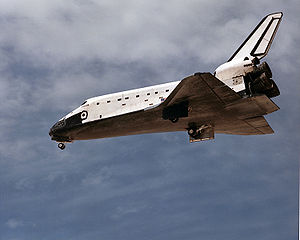 Landing of NASA Space Shuttle Atlantis. The American Space Shuttles were manned orbital spaceplanes.
Landing of NASA Space Shuttle Atlantis. The American Space Shuttles were manned orbital spaceplanes.
A spaceplane features some differences from rocket launch systems.
Aerodynamic lift
Main article: Lift (force)All aircraft utilize aerodynamic surfaces in order to generate lift. For spaceplanes different shaped wings can be used, delta wings are common, but straight wings, lifting bodies and even rotorcraft have been proposed. Typically the force of lift generated by these surfaces is many times that of the drag that they induce. The ratio of these forces (the Lift-to-drag ratio or L/D) varies between different aircraft designs. It can be as high as 60 in high performance gliders, but is usually closer to 7 or less for typical supersonic aircraft configurations, but may be significantly lower for hypersonic aerospace planes.[citation needed]
In practice a lift to drag ratio of 7 means that a thrust force equal to 1/7 of the weight of the aircraft is sufficient to support it in flight. This low thrust requirement significantly reduces the amount of fuel required to carry the weight of an aerospace plane in comparison to rocket launch systems which must provide thrust greater than the weight of the vehicle.[citation needed]
A partially off-setting difference between these systems is that the aerospace plane would typically experience powered flight for much longer periods of time than a rocket. In addition winged vehicles need extra dry mass for the wings, and this penalizes vehicles towards the end of the flight. Rockets are also able to use their high thrust at an angle which gives reasonable lifting efficiency when burning for orbit. However, spaceplanes typically undergo what is called[by whom?] a "zoom maneuver" when transitioning from air-breathing flight to pure rocket propulsion to reach space, in which they change their attitude and climb rate significantly, translating some forward velocity into vertical velocity in order to get above the remaining atmosphere so the rocket engine can operate most efficiently.[citation needed]
Atmospheric reentry
Because suborbital spaceplanes are designed for trajectories that do not reach orbital speed, they do not need the kinds of thermal protection orbital spacecraft required during the hypersonic phase of atmospheric reentry. The Space Shuttle thermal protection system, for example, protects the orbiter from surface temperatures that could otherwise reach as high as 3,000 °F (1,650 °C), well above the melting point of steel.[1]
Propulsion
Rocket engines
All spaceplanes to date have used rocket engines with chemical fuels. Due to the orbital insertion burn necessarily being done in space, orbital spaceplanes require rocket engines for at least that portion of the flight.
Air breathing engines
Main article: Airbreathing jet engineA difference between rocket based and air-breathing aerospace plane launch systems is that aerospace plane designs typically include minimal oxidizer storage for propulsion. Air-breathing aerospace plane designs include engine inlets so they can use atmospheric oxygen for combustion. Since the mass of the oxidizer is, at takeoff, the single largest mass of most rocket designs (the Space Shuttle's liquid oxygen tank weighs 629,340 kg, more than one of its solid rocket boosters[2]), this provides a huge potential weight savings benefit. However, air breathing engines are usually very much heavier than rocket engines and the empty weight of the oxidiser tank, and since, unlike oxidiser, this extra weight must be carried into space it greatly offsets the overall system performance.
Types of air breathing engines proposed for spaceplanes include scramjet, liquid air cycle engines, precooled jet engines, pulse detonation engine and ramjets. Some engine designs combine several types of engines features into a combined cycle. For instance, the Rocket-based combined cycle (RBCC) engine uses a rocket engine inside a ramscoop so that at low speed, the rockets thrust is boosted by ejector augmented thrust. It then transitions to ramjet propulsion at near-supersonic speeds, then to supersonic combustion or scramjet propulsion, above Mach 6, then back to pure rocket propulsion above Mach 10.
Harsh flight environment
The flight trajectory required of air-breathing aerospace vehicles to reach orbit is to fly what is known as a 'depressed trajectory' which places the aerospace plane in the high-altitude hypersonic flight regime of the atmosphere. This environment induces high dynamic pressure, high temperature, and high heat flow loads particularly upon the leading edge surfaces of the aerospace plane. These loads typically require special advanced materials, active cooling, or both for the structures to survive the environment.
However, even rocket-powered spaceplanes can face a significant thermal environment if they are burning for orbit, but this is nevertheless far less severe than air-breathing spaceplanes.
Suborbital space planes designed to briefly reach space do not require significant thermal protection, as they experience peak heating for only a short time during re-entry. Intercontinental suborbital trajectories require much higher speeds and thermal protection more similar to orbital spacecraft reentry.
Center of mass issues
A wingless launch vehicle has lower aerodynamic forces affecting the vehicle, and attitude control can be active perhaps with some fins to aid stability. For a winged vehicle the centre of lift moves during the atmospheric flight as well as the centre of mass; and the vehicle spends longer in the atmosphere as well. Historically, the X-33 and HOTOL spaceplanes were rear engined and had relatively heavy engines. This puts a heavy mass at the rear of the aircraft with wings that had to hold up the vehicle. As the wet mass reduces, the centre of mass tends to move rearward behind the centre of lift, which tends to be around the centre of the wings. This can cause severe instability that is usually solved by extra fins which add weight and decrease performance.
Overall weight
A vertically launched rocket forms the shape of a cylinder stood on end. This structure can be made very light and strong. A horizontally launched spaceplane approximates a cylinder on its side. This structure experiences greater bending forces, so must be strengthened. This makes it heavier, requiring advanced materials and design techniques to reduce weight. For example Burt Rutan of Scaled Composites recently patented a method of gluing the fuel tank directly to the vehicle skin, saving the weight of fasteners while also stiffening both parts.[citation needed]
Single stage to orbit
Future orbital spaceplanes may take off, ascend, descend, and land like conventional aircraft, providing true single stage to orbit (SSTO) capability.
Proponents of scramjet technology often cite such a vehicle as being a possible application of that type of engine, however pure rocket and subsonic combustion jet designs have also been proposed and may be easier to design and build. The main problem with SSTO operation is overall weight.
Flown spaceplanes
Orbital spaceplanes
All four of the orbital spaceplanes successfully flown to date utilize a VTHL (vertical takeoff, horizontal landing) design. They include the piloted United States Space Shuttle and three unmanned spaceplanes: the early-1980s BOR-4 (subscale test vehicle for the Spiral spaceplane that was subsequently cancelled), the late-1980s Soviet Buran, and the early-2010s Boeing X-37.
These vehicles have used wings to provide aerobraking to return from orbit and to provide lift, allowing them to land on a runway like conventional aircraft. These vehicles are still designed to ascend to orbit vertically under rocket power like conventional expendable launch vehicles. One drawback of spaceplanes is that they have a significantly smaller payload fraction than a ballistic design with the same takeoff weight. This is in part due to the weight of the wings — around 9-12% of the weight of the atmospheric flight weight of the vehicle. This significantly reduces the payload size, but the reusability is intended to offset this disadvantage.
While all spaceplanes have used atmospheric lift for the reentry phase, none to date have succeeded in a design that relies on aerodynamic lift for the ascent phase in reaching space (excluding mothership first stage). Efforts such as the Sanger and X-30/X-33 have all failed to materialize into a vehicle capable of successfully reaching space. The Pegasus winged booster has had many successful flights to deploy orbital payloads, but since its aerodynamic vehicle component operates only as a booster, and not operate in space as a spacecraft, it is not typically considered to be a spaceplane.
On the other hand, OREX[3] is a test vehicle of HOPE-X and launched into 450 km LEO using H-II in 1994. OREX succeeded to reenter, but it was only hemispherical head of HOPE-X, that is, not plane-shaped.
Suborbital spaceplanes
Other spaceplane designs are suborbital, requiring far less energy for propulsion, and can use the vehicle's wings to provide lift for the ascent to space in addition to the rocket. As of 2010, the only such craft to reach space have been the X-15, SpaceShipOne and ASSET (flown as a subscale precursor to the X-20 Dyna-Soar spaceplane program that was subsequently canceled). None of these craft were capable of entering orbit. The X-15 and SpaceShipOne both began their independent flight only after being lifted to high altitude by a carrier aircraft.
Scaled Composites and Virgin Galactic unveiled on December 7, 2009, the SpaceShipTwo space plane, the VSS Enterprise, and its WhiteKnightTwo mothership, "Eve". SpaceShipTwo is designed to carry two pilots and six passengers on suborbital flights, with flight testing scheduled to be completed in the 2012 time frame.
XCOR Aerospace signed a $30 million contract with Yecheon Astro Space Center to build and lease its Lynx Mark II spaceplane, which would be designed to take off from a runway under its own rocket power, and to reach the same altitude and speed range as SpaceShipOne and SpaceShipTwo, due to the fact that Lynx is propelled by higher specific impulse fuels. Lynx is designed to only carry a pilot and one passenger, although tickets are expected to be around half those quoted for Virgin Galactic services.[4]
Hyflex[5][6] is a miniaturized suborbital demonstrator of HOPE-X launched in 1996. Hyflex flew 110 km altitude and succeeded to reenter, though it was failed to recover.
See also: Rocket-powered aircraftOther projects
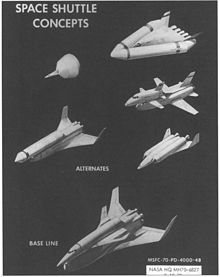 United States STS Space shuttle concepts circa 1970s
United States STS Space shuttle concepts circa 1970s
Various types of spaceplanes have been suggested since the early twentieth century. Notable early designs include Friedrich Zander's spaceplane equipped with wings made of combustible alloys that it would burn during its ascent, and Eugen Sänger's Silbervogel bomber design. Also in Nazi Germany and then in the USA, winged versions of the V2 rocket were considered during and after World War II, and when public interest in space exploration was high in the 1950s and '60s, winged rocket designs by Wernher von Braun and Willy Ley served to inspire science fiction artists and filmmakers.
United States
The U.S. Air Force invested some effort in a paper study of a variety of spaceplane projects under their Aerospaceplane efforts of the late 1950s, but later ended these when they decided to use a modified version of Sänger's design. The result, Boeing X-20 Dyna-Soar, was to have been the first orbital spaceplane, but was canceled in the early 1960s in lieu of NASA's Project Gemini and the U.S. Air Force's Manned Orbiting Laboratory program. The Rockwell X-30 National Aero-Space Plane (NASP), begun in the 1980s, was an attempt to build a scramjet vehicle capable of operating like an aircraft and achieving orbit like the shuttle. It was canceled due to increasing technical challenges, growing budgets, and the loss of public interest. In 1994 Mitchell Burnside Clapp proposed a single stage to orbit peroxide/kerosene spaceplane called "Black Horse".[7] This was notable in that it was to take off almost empty and undergo mid-air refueling before accelerating to orbit.[citation needed]
The Lockheed Martin X-33 was a prototype made as part of an attempt by NASA to build a SSTO hydrogen-fuelled spaceplane VentureStar that failed when the hydrogen tank design proved to be unconstructable in the planned way. The March 5, 2006 edition of Aviation Week & Space Technology published a story purporting to be "outing" a highly classified U.S. military two-stage-to-orbit spaceplane system with the code name Blackstar, SR-3/XOV among other nicknames. The alleged system, using an XB-70-like first-stage mother ship, capable of Mach 3, is said to launch an upper-stage "waverider" spaceplane capable of carrying small payloads and crews near to or into orbit or on skip-diving flights, ostensibly for reconnaissance and other missions, achieving surprise that cannot be attained by satellite. There has been considerable controversy over this story and its claims.[citation needed]
In 1999 NASA started the Boeing X-37 project, an unmanned, remote controlled spaceplane. The project was transferred to the U.S. Department of Defense in 2004. It had its first flight as a drop test on 7 April 2006, at Edwards Air Force Base. The spaceplane's first orbital mission, USA-212 was launched on 22 April 2010 using an Atlas V rocket, and the heat shield and hypersonic aerodynamic handling was tested. A second X-37B test flight was launched on 5 March 2011.[citation needed]
Boeing has proposed that a larger variant of the X-37B, the X-37C could be built to carry up to six passengers up to LEO. The spaceplane would also be usable for carrying cargo, with both upmass and downmass (return to Earth) cargo capacity. The ideal size for the proposed derivative "is approximately 165 to 180 percent of the current X-37B."[8]
In December 2010, Orbital Sciences made a commercial proposal to NASA to develop the Prometheus, a lifting-body spaceplane vehicle about one-quarter the size of the Space Shuttle, in response to NASA's Commercial Crew Development (CCDev) phase 2 solicitation. The vehicle would be launched on a human-rated (upgraded) Atlas V rocket but would land on a runway.[9] For the same solicitation, Sierra Nevada Corporation proposed phase 2 extensions of its Dream Chaser spaceplane technology, partially developed under the first phase of NASA's CCDev program.[10] Both the Orbital Sciences proposal and the Dream Chaser are lifting body designs.[11] Sierra Nevada will utilize Virgin Galactic to market Dream Chaser commercial services and may use "Virgin’s WhiteKnightTwo carrier aircraft as a platform for drop trials of the Dream Chaser atmospheric test vehicle"[10][12] NASA expects to make approximately $200 million of phase 2 awards by March 2011, for technology development projects that could last up to 14 months.[13]
National Aerospace Plane
President Ronald Reagan described NASP in his 1986 State of the Union address as "...a new Orient Express that could, by the end of the next decade, take off from Dulles Airport and accelerate up to twenty-five times the speed of sound, attaining low earth orbit or flying to Tokyo within two hours..."[14]
There were six identifiable technologies which were considered critical to the success of the NASP project. Three of these "enabling" technologies were related to the propulsion system, which would consist of a hydrogen-fueled scramjet.[14] The NASP program became the Hypersonic Systems Technology Program (HySTP) in late 1994.
HySTP was designed to transfer the accomplishments made in hypersonic technologies by the National Aero-Space Plane (NASP) program into a technology development program. On January 27, 1995 the Air Force terminated participation in (HySTP).[14]
Soviet Union and Russia
 Buran orbiter being transported via An-225
Buran orbiter being transported via An-225
The Soviet Union firstly considered a preliminary design of rocket-launch small spaceplane Lapotok in early 1960s. Then the Spiral airspace system with small orbital spaceplane and rocket as second stage was widely developed in the 1960s-1980s. Although test flights of prototypes of spaceplane were fulfilled in air (MiG-105) and space (BOR-4), program was canceled in 1987, a year before the first Buran flight. Project of Tupolev Design Bureau of military suborbital spaceplane-bomber Tu-136/139 Zvezda was canceled in early stage. Another project of Uragan spaceplane, a smaller sibling to Buran, launched by Proton and Zenit rockets, never been confirmed by Soviet or Russian authorities as really conducted, although an existence of similar project of Chelomei's LKS (Kosmolyot) spaceplane was confirmed.[citation needed]
Cosmoplane
In recent times, an orbital spaceplane, called cosmoplane (Russian: космоплан) capable of transporting passengers has been proposed by Russia's Institute of Applied Mechanics. According to researchers, it could take about 20 minutes to fly from Moscow to Paris, using hydrogen and oxygen fueled engines.[15][16]
France
Initiated by France joint European program of ESA of Hermes manned spaceplane launched by Ariane rocket continued a few years before it was canceled in early 1990s. Earlier France Dassault-Avion company proposed Astrobus spaceplane and now develops ARES spaceplane as prototype for FLPP. Hopper was proposed as European spaceplane by EADS which also develops ARES spaceplane as prototype for ESA FLPP/FLTP program and commercial suborbital spaceplane for space tourism.[citation needed]
Japan
HOPE was a Japanese experimental spaceplane project designed by a partnership between NASDA and NAL (both now part of JAXA), started in the 1980s. It was positioned for most of its lifetime as one of the main Japanese contributions to the International Space Station, the other being the Japanese Experiment Module. The project was eventually cancelled in 2003, by which point test flights of a sub-scale testbed had flown successfully.
Germany
After the German Sänger-Bredt RaBo and Silbervogel of the 1930s and 1940s, Eugen Sänger worked for time on various space plane projects, coming up with several designs for Messerschmitt-Bölkow-Blohm such as the MBB Raumtransporter-8.[17] In the 1980s, West Germany funded design work on the MBB Sänger II with the Hypersonic Technology Program. Development continued on MBB/Deutsche Aerospace Sänger II/HORUS until the last 1980s, when it was canceled. Germany went on to participate in the Ariane rocket, Columbus space station and Hermes spaceplane of ESA, Spacelab of ESA-NASA and Deutschland missions (non-U.S. funded Space Shuttle flights with Spacelab). The Sänger II had predicted cost savings of up to 30 percent over expendable rockets.[18][19] The Daimler-Chrysler Aerospace RLV was a much later small reusable spaceplane prototype for ESA FLPP/FLTP program.
United Kingdom
The Multi-Unit Space Transport And Recovery Device (MUSTARD) was a concept explored by the British Aircraft Corporation (BAC) around 1964-1965 for launching payloads weighing as much as 5,000 lb into orbit. It was never constructed.[20] The British Government also began development of a SSTO-spaceplane, called HOTOL, but the project was canceled due to technical and financial issues.[21]
The lead engineer from the HOTOL project has since set up a private company dedicated to creating a similar plane called Skylon with a different combined cycle rocket/turbine precooled jet engine called SABRE. This vehicle is intended to be capable of a single stage to orbit launch also and, if successful, would be far in advance of anything currently in operation.[22]
India
AVATAR (Sanskrit: अवतार) (from "Aerobic Vehicle for Hypersonic Aerospace TrAnspoRtation") is a single-stage reusable spaceplane capable of horizontal takeoff and landing, being developed by India's Defense Research and Development Organization along with Indian Space Research Organization and other research institutions; it could be used for cheaper military and civilian satellite launches.
See also
- Ansari X Prize
- List of manned spacecraft
- List of private spaceflight companies#Crew and cargo transport vehicles
- Spaceflight
References
- ^ "ORBITER THERMAL PROTECTION SYSTEM". NASA KSC. 1989. http://www-pao.ksc.nasa.gov/kscpao/nasafact/tps.htm.
- ^ Space Shuttle external tank#Technical data
- ^ "OREX". Space Transportation System Research and Development Center, JAXA. http://www.rocket.jaxa.jp/fstrc/0c01.html. Retrieved 2011-05-15.
- ^ Andy Pasztor (December 17, 2009). "XCOR Aerospace Gets First Lease Customer for Its Space Plane". The Wall Street Journal. http://online.wsj.com/article/SB10001424052748704238104574602492468293788.html.
- ^ "Hyflex". astronautix.com. http://www.astronautix.com/craft/hyflex.htm. Retrieved 2011-05-15.
- ^ "HYFLEX". Space Transportation System Research and Development Center, JAXA. http://www.rocket.jaxa.jp/fstrc/0c02.html. Retrieved 2011-05-15.
- ^ Black Horse. astronautix.com
- ^ David, Leonard (2011-10-07). "Secretive US X-37B Space Plane Could Evolve to Carry Astronauts". space.com. http://www.space.com/13230-secretive-37b-space-plane-future-astronauts.html. Retrieved 2011-10-13.
- ^ "Orbital Proposes Spaceplan for Astronauts". Wall Street Journal, December 14, 2010. Accessed: December 15, 2010.
- ^ a b Orbital Aims For Station With Lifting Body, Aviation Week, 2010-12-17, accessed 2010-12-20. "will use Virgin to market its services. But Sierra is also in discussions about using Virgin’s WhiteKnightTwo carrier aircraft as a platform for drop trials of the Dream Chaser atmospheric test vehicle"
- ^ Companies submit plans for new NASA spacecraft, Daily Record, 2010-12-17, accessed 2010-12-20.
- ^ Virgin joins forces with two companies on CCDev, NewSpace Journal, 2010-12-16, accessed 2010-12-18.
- ^ "NASA Seeks More Proposals On Commercial Crew Development". press release 10-277. NASA. October 25, 2010. http://www.nasa.gov/home/hqnews/2010/oct/HQ_10-277_CCDev.html.
- ^ a b c "X-30 National Aerospace Plane (NASP)". Federation of American Scientists. http://www.fas.org/irp/mystery/nasp.htm. Retrieved 2010-04-30.
- ^ Russia Develops New Aircraft – Cosmoplane
- ^ RusUsa.com Космоплан – самолет будущего
- ^ http://www.astronautix.com/lvs/saengeri.htm
- ^ http://www.astronautix.com/lvs/saegerii.htm
- ^ http://www.fas.org/spp/guide/germany/piloted/index.html
- ^ David Darling (2010). "MUSTARD INFO". http://www.daviddarling.info/encyclopedia/M/MUSTARD.html. Retrieved 29 September 2010.
- ^ "HOTOL History". Reaction Engines Limited. 2010. http://www.reactionengines.co.uk/bkgrnd.html. Retrieved 29 September 2010.
- ^ "Skylon FAQ". Reaction Engines Limited. 2010. http://www.reactionengines.co.uk/faq.html#q6. Retrieved 29 September 2010.
External links
- Encyclopedia Astronautica article on Uragan / Zenit
- Russianspacweb: Russian Reusable Spacecraft
- Popular Science article: Space Shuttle proposals written by Wernher von Braun - July 1970
- Popular Science article: VentureStar, X-34, MAKS, Burlak and other - October 1996
- Popular Science article: Space Access' Space Plane - January 1998
- Popular Science article: Space planes - May 1999
- Popular Science article: Space plane replacement of Space Shuttle and info on past designs including NASP and Clipper - May 2003
Spaceplanes Canada CanceledFutureChina FutureProject 921-3 · ShenlongEurope (ESA) CanceledHermes · HopperFrance CanceledAstrobusFutureARESGermany CanceledSilbervogel · Sänger-Bredt RaBo · MBB Raumtransporter-8 · MBB Sänger II · MBB Deutsche Aerospace HORUSFutureDaimler-Chrysler Aerospace RLV · EADS Astrium SpaceplaneIndia CanceledFutureAVATAR · Indian Space Shuttle ProgramJapan HistoricalCanceledRomania FutureRussia CanceledFutureSoviet Union HistoricalCanceledUnited Kingdom CanceledFutureUnited States ActiveHistoricalCanceledChrysler SERV · Martin Marrietta Spacemaster · X-20 Dyna-Soar · Orbital Sciences X-34 · Rockwell X-30 (NASP) · NASA X-43 · Silver Dart · HL-20 · Rocketplane XP · VentureStar · Black Horse · NASA X-38 (Spacewedge) · Xerus · PrometheusFutureBlack projectsBlackstar · TR-3A Black Manta · TAW-50 · X-41 Common Aero Vehicle · Aurora aircraft · Military flying saucers · Military space shuttleNon-rocket spacelaunch Static structures CompressiveSpace towerTensileBolusRotovators · Hypersonic bolusOtherEndo-atmospheric tethers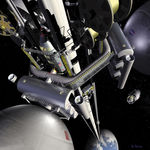
Dynamic structures Projectile launchers ElectricalChemicalMechanicalSlingatronReaction drives Buoyant lifting Space tourism Companies Armadillo Aerospace · Bigelow Aerospace · Blue Origin · EADS Astrium · Mojave Aerospace Ventures · Orbital Sciences Corporation · RocketShip Tours · Scaled Composites · Space Adventures · SpaceX · Virgin Galactic · XCOR Aerospace
Organizations Successful spacecraft Living in space Space competitions Categories:- Spaceplanes
- Air launch to orbit
- Emerging technologies
Wikimedia Foundation. 2010.

